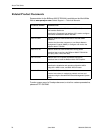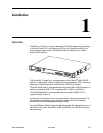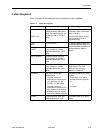
2600-A2-GN20-20 June 2004 B
Important Safety Instructions
1. Read and follow all warning notices and instructions marked on the product or included in the manual.
2. This product is intended to be used with a 3-wire grounding type plug — a plug that has a grounding pin. This is a
safety feature. Equipment grounding is vital to ensure safe operation. Do not defeat the purpose of the grounding
type plug by modifying the plug or using an adapter. Prior to installation, use an outlet tester or a voltmeter to check
the AC receptacle for the presence of earth ground. If the receptacle is not properly grounded, the installation must
not continue until a qualified electrician has corrected the problem.
If a 3-wire grounding type power source is not available, consult a qualified electrician to determine another
method of grounding the equipment.
3. Slots and openings in the cabinet are provided for ventilation. To ensure reliable operation of the product and to
protect it from overheating, these slots and openings must not be blocked or covered.
4. Do not allow anything to rest on the power cord and do not locate the product where persons will walk on the power
cord.
5. Do not attempt to service this product yourself, as it will void the warranty. Opening or removing covers may expose
you to dangerous high voltage points or other risks. Refer all servicing to qualified service personnel.
6. General purpose cables are described for use with this product. Special cables, which may be required by the
regulatory inspection authority for the installation site, are the responsibility of the customer. To reduce the risk of
fire, use a UL Listed or CSA Certified, minimum No. 26 AWG (0.128 mm
2
) telecommunication cable, or
comparable cables certified for use in the country of installation.
7. When installed in the final configuration, the product must comply with the applicable Safety Standards and
regulatory requirements of the country in which it is installed. If necessary, consult with the appropriate regulatory
agencies and inspection authorities to ensure compliance.
8. A rare phenomenon can create a voltage potential between the earth grounds of two or more buildings. If products
installed in separate buildings are interconnected, the voltage potential may cause a hazardous condition. Consult
a qualified electrical consultant to determine whether or not this phenomenon exists and, if necessary, implement
corrective action prior to interconnecting the products.
9. In addition, if the equipment is to be used with telecommunications circuits, take the following precautions:
— Never install telephone wiring during a lightning storm.
— Never install telephone jacks in wet locations unless the jack is specifically designed for wet locations.
— Never touch uninsulated telephone wires or terminals unless the telephone line has been disconnected at the
network interface.
— Use caution when installing or modifying telephone lines.
— Avoid using a telephone (other than a cordless type) during an electrical storm. There may be a remote risk of
electric shock from lightning.
— Do not use the telephone to report a gas leak in the vicinity of the leak.
10. CLASS 1 LASER PRODUCT: This product has provisions for the customer to install a Class 1 laser transciever,
which provides optical coupling to the telecommunication network. Once a Class 1 laser product is installed, the
equipment is to be considered to be a Class 1 Laser Product (Appareil à Laser de Classe 1). The customer is
responsible for selecting and installing the laser transciever and for insuring that the Class 1 AEL (Allowable
Emission Limit) per EN/IEC 60825 is not exceeded after the laser transponders have been installed. Do not install
laser products whose class rating is greater than 1. Refer to all important safety instructions that accompanied the
transciever prior to installation. Only laser Class 1 devices, certified for use in the country of installation by the
cognizant agency are to be utilized in this product.
11. Input power to the ALARM relay interface (located on the front panel of the enclosure) must not exceed 30V rms or
60 VDC.
12. The equipment is intended for installation in a max. 65° C ambient temperature, in an environment that is free of
dust and dirt.
!


















